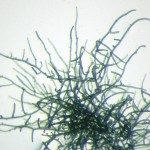Lien vers Pubmed [PMID] – 23950996
PLoS ONE 2013;8(8):e70747
Microcystis aeruginosa is one of the most common bloom-forming cyanobacteria in freshwater ecosystems worldwide. This species produces numerous secondary metabolites, including microcystins, which are harmful to human health. We sequenced the genomes of ten strains of M. aeruginosa in order to explore the genomic basis of their ability to occupy varied environments and proliferate. Our findings show that M. aeruginosa genomes are characterized by having a large open pangenome, and that each genome contains similar proportions of core and flexible genes. By comparing the GC content of each gene to the mean value of the whole genome, we estimated that in each genome, around 11% of the genes seem to result from recent horizontal gene transfer events. Moreover, several large gene clusters resulting from HGT (up to 19 kb) have been found, illustrating the ability of this species to integrate such large DNA molecules. It appeared also that all M. aeruginosa displays a large genomic plasticity, which is characterized by a high proportion of repeat sequences and by low synteny values between the strains. Finally, we identified 13 secondary metabolite gene clusters, including three new putative clusters. When comparing the genomes of Microcystis and Prochlorococcus, one of the dominant picocyanobacteria living in marine ecosystems, our findings show that they are characterized by having almost opposite evolutionary strategies, both of which have led to ecological success in their respective environments.




